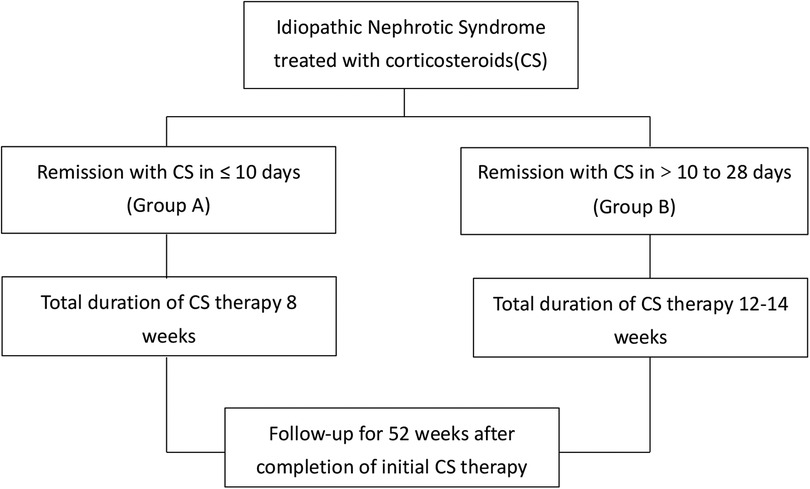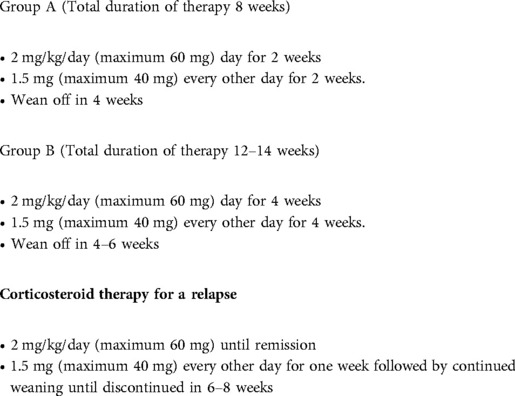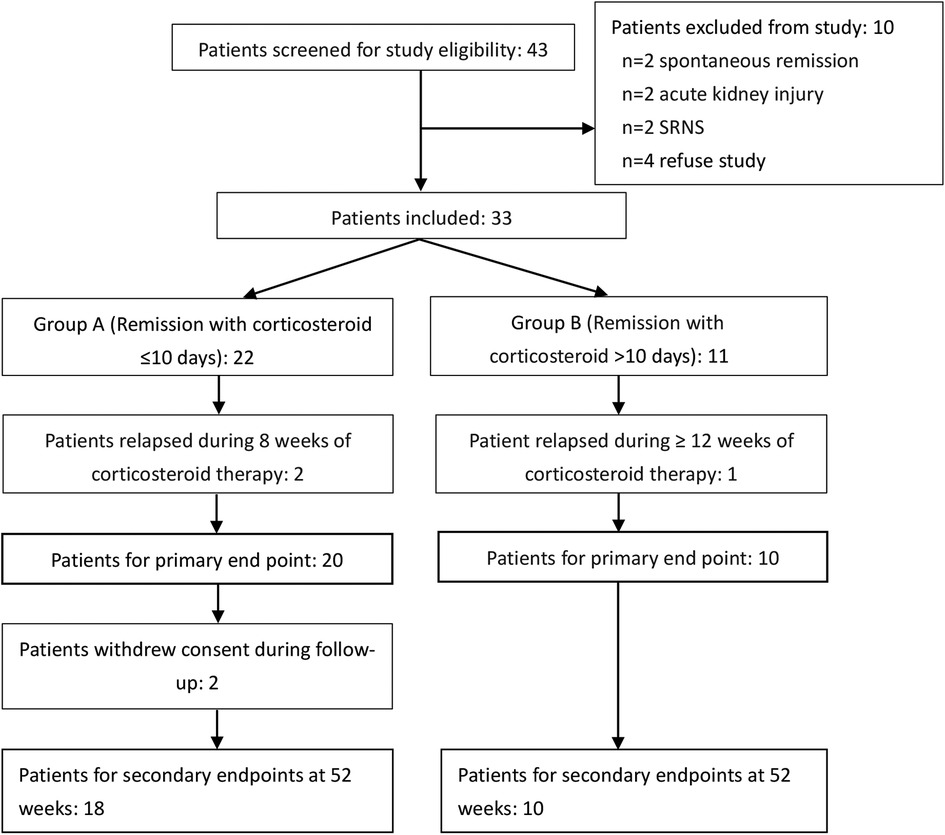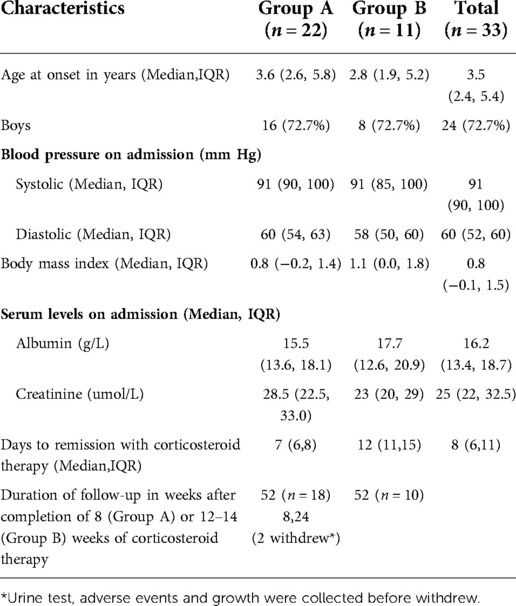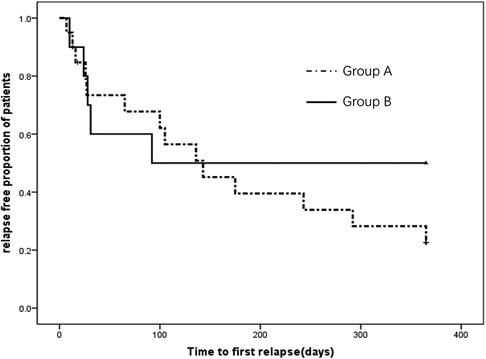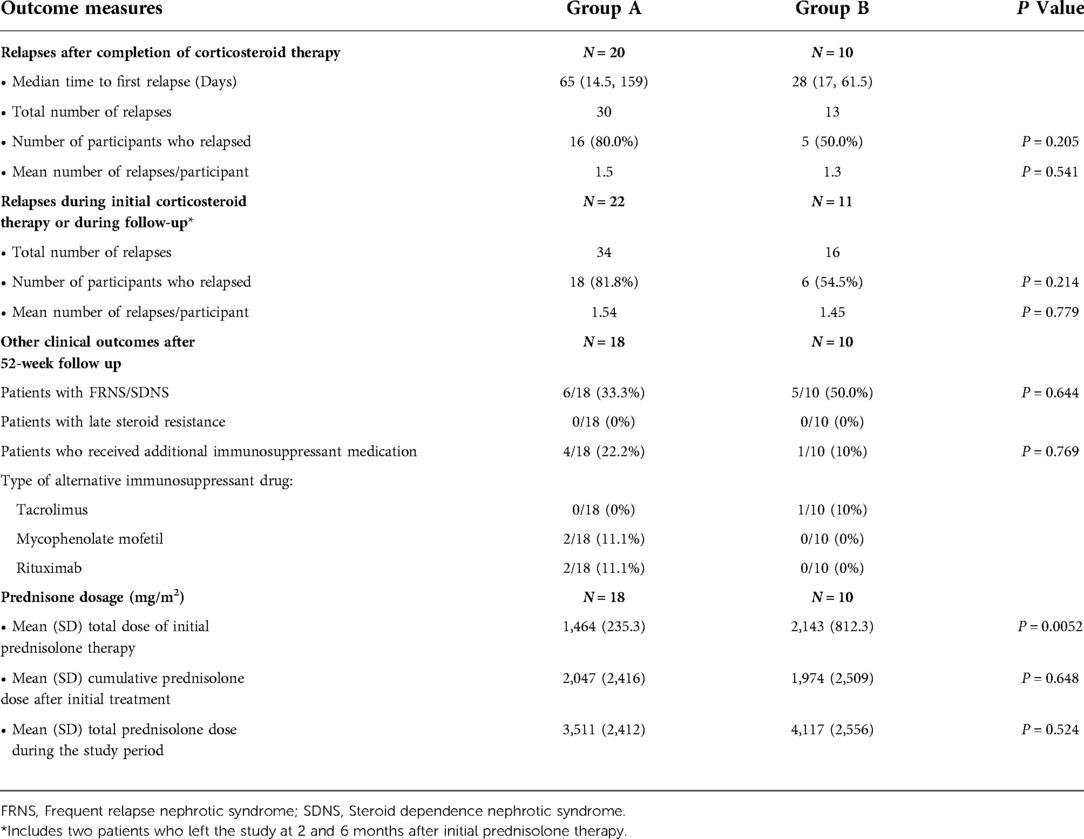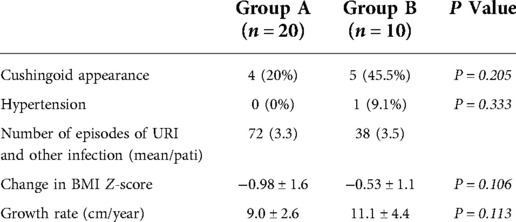- 1Department of Nephrology, Shanghai Kidney Development and Pediatric Kidney Disease Research Center, National Children's Medical Center, Children's Hospital of Fudan University, Shanghai, China
- 2Division of Pediatric Nephrology, Department of Pediatrics, Wayne State University School of Medicine, Detroit, MI, United States
Background: The duration of initial corticosteroid therapy in newly diagnosed Idiopathic nephrotic syndrome (INS) is about 3 months. Our study was designed to test the feasibility of a shorter duration of corticosteroid therapy in newly diagnosed INS who show a quicker response.
Methods: Patients who responded within 10 days (Group A) received 8 weeks of corticosteroid therapy as compared to 12–14 weeks of standard therapy in those who responded between >10 days to 28 days (Group B), and follow up for 52 weeks. The primary endpoint is time to first relapse after treatment completion. (NCT03878914, March 18, 2019)
Results: A total of 33 children with INS were enrolled and the follow-up data were analyzed. The clinical and laboratory characteristics of patients in both groups were similar. No significant difference was found in time to first relapse [65(14.5, 159) days for Group A vs. 28(17, 61.5) days for Group B, P = 0.371], the incidence of frequently relapsing nephrotic syndrome [6/18 (33.3%) vs. 5/10(50%), P = 0.644] or requirement for alternative immunosuppressant [4/18 (22.2%) vs. 1/10 (10%), P = 0.769]. Group A received similar corticosteroid dose compare with Group B (3511 ± 2421 mg/m2 vs. 4117 ± 2556 mg/m2, P = 0.524). Frequency and severity of corticosteroid-related complications was similar in both groups.
Conclusions: The time to first relapse and the number of relapses per patient were comparable between the two groups. However, more patients in Group A relapsed and the mean total dose of prednisolone for the study period was very similar between the two groups.
Introduction
Idiopathic nephrotic syndrome (INS) is the most common glomerular disease in childhood and corticosteroid therapy is its most effective treatment (1). Although 90% of patients respond by going into complete remission, 70%–80% of patients relapse and, of these, 50% have frequent relapses (FR) or become steroid-dependent (SD) (2). Since inception of corticosteroids in the management of INS by the ISKDC (3), numerous studies have been done with the objective of optimizing response and minimizing the side effects of corticosteroid therapy. Recent studies have demonstrated that the optimal duration of initial corticosteroid therapy should be two to three months and extending it >12 weeks does not significantly improve the outcome (4). The current Kidney Disease: Improving Global outcomes (KDIGO) guidelines recommend a total of 8 or 12 weeks of corticosteroids for all children diagnosed with INS (5). All studies in the past were designed on the principle of single treatment regimen for all patients. No study has ever been done to explore the possibility of treatment duration based on any of the patient characteristics, including time to remission. Patients who respond to corticosteroids within 7 to 10 days are known to have significantly fewer recurrence and a better outcome (6–8). The objective of our study was to test the feasibility of a shorter duration of initial corticosteroid therapy in newly diagnosed patients with INS who show a quicker treatment response.
Methods
Study design and patients
We conducted a prospective, open-label, observational cohort study of children with steroid sensitive nephrotic syndrome(SSNS). The study was Initially, designed to enroll a sample size of 64 patients from multiple international study sites (ClinicalTrials.gov, NCT03878914). However, due to the unforeseen disruption caused by COVID-19 pandemic, only one site, Children's Hospital of Fudan University, was able to recruit and allocatedstudy patients and complete follow-up as per the study protocol. Children aged 1 to 19 years old with newly diagnosed SSNS were consecutively included in this study. Patients with high serum creatinine at the time of admission, abnormal labs suggestive of secondary NS, or resistance to initial corticosteroid therapy were excluded from the study. RedCap was used for data collection and management. The Institutional Review Board (IRB) of Wayne State University and Children's Hospital of Fudan University approved and monitored this study (020719MP2F, CFHDU-2019-203, NCT03878914).
As shown in Figure 1, patients were divided into two groups based on time to remission. Patients who achieved remission in ≤10 days (Group A) received prednisolone for a total of 8 weeks where as those who responded between 10 days to 28 days (Group B) received 12–14 weeks of prednisolone. Details on initial steroid therapy and the treatment of relapse(es) for the two groups is shown in Table 1.
Definitions used in the study were as follows:
Nephrotic syndrome: Presence of pitting edema with hypoalbuminemia (albumin ≤ 2.5 g/dl or ≤25 g/L) and proteinuria (≥300 mg/dl or 3+ on dipstick, or urine protein/creatinine ≥ 2).
Remission: Urine dipstick negative to trace or urine protein/creatinine of <0.2 for 3 days.
Relapse: Protein ≥ 300 mg/dl or 3+ on dipstick, or urine protein/creatinine ≥ 0.2 for 3 days.
Frequent relapses: ≥2 relapses within 6 months of initial response or ≥ 4 relapses/12 months.
Steroid dependence: 2 consecutive relapses during CS therapy or within 14 days of discontinuation.
Steroid resistance (Early): No response after 4 weeks of initial CS therapy.
Steroid resistance (Late): No response after 4 weeks of CS therapy for a relapse.
Patients were followed for 52 weeks after completion of initial steroid therapy. Follow-up consisted of outpatient clinic visits and/or video conference at least once every month while on corticosteroids and once every two months when not on corticosteroids. Parents were instructed to examine the first morning urine for protein by dipstick.
The primary study endpoint was time to first relapse after completion of initial steroid therapy. The secondary endpoints included number of relapses during follow-up, number of patients with frequent relapses and or corticosteroid dependence, and the cumulative steroid dose in the two groups.
Statistical analyses
A two-sample parametric t-test or non-parametric Mann Whitney U test will be employed to examine the mean difference between patients receiving the standard treatment and those receiving prolonged treatment. Categorical data were analyzed with Pearson's chi-square or Fisher's exact test. We used Kaplan-Meier survival curves to visually present the time to first relapse, and compared between groups using a log rank test. Statistical significance will be considered achieved at a P-value < 0.05. All statistical procedures will be conducted using SPSS 17.0.
Results
Between August 2019 and July 2020, 43 patients were screened at Fudan University for eligibility and a total of 33 INS children meeting criterion were enrolled in this study. Another 10 patients were excluded due to spontaneous remission (n = 2), AKI (n = 2), SRNS (n = 2), refusing study (n = 4). One patient with INS was screened at the Wayne State University but was excluded because of steroid resistance. Three patients (two in Group A and one in Group B) relapsed while on initial corticosteroid treatment. Other two patients in Group A were lost to follow up when they relapsed after completion of initial corticosteroid treatment. Altogether 33 patients were randomized and 28 completed the follow-up (Figure 2).
The median time of response to corticosteroid therapy in 33 patients was 8 (6,11) days; 66.7% (n = 22/33) responded within 10 days (Group A) and 33.3% (n = 11/33) responded after 10 days (Group B). The clinical and laboratory characteristics of patients in both groups were similar as shown in Table 2. The mean age of disease onset was 3.5 (2.4, 5.4) years; 3.6(2.6, 5.8) years in Group A and 2.8 (1.9, 5.2) years in Group B (P = 0.911). Most patients enrolled were boys (n = 24,72.7%). The body mass index SDS was similar between two group [0.8(−0.2, 1.4) vs. 1.1(0.0, 1.8), P = 0.597] and all patients had normal blood pressure at study enrolment. There was no difference in serum creatinine and albumin between the two groups.
Figure 3 show that the time to first relapse after initial corticosteroid therapy were not significantly different between Group A and Group B patients (Log rank P = 0.371). The median time to first relapse was 65 (interquartile range 14.5–159) days for Group A vs. 28 (17–61.5) days for Group B (Table 3). In Group A, 18 of 22 (81.8%) patients had a relapse as compared to 6 of 11 patients (54.5%) in Group B. Included were three patients (2 in Group A, 1 in Group B) who relapsed during initial corticosteroid therapy.
Follow-up for 52-weeks was available for 18 and 10 patients in Group A and B, respectively. Two patients from Group A withdrew from the study at 2 and 6 months after completion of initial corticosteroid therapy due to non-adherence to relapse regimen, and they experienced 1 and 3 relapses, respectively, by the time of study withdrawal. A total of 34 and 16 disease recurrences were recorded in Group A and Group B respectively during or after initial corticosteroid therapy. Numbers of relapses per patient were similar (1.54 for Group A vs. 1.45 for Group B, P = 0.779), and there was no difference in the proportion of relapsed patients between the tow groups (P = 0.214). No significant difference was found in the incidence of FRNS/SDNS [group A 6/18 (33.3%) vs. group B 5/10(50%), P = 0.644] or requirement for alternative immunosuppressive treatment [4/18 (22.2%) vs. 1/10 (10%), P = 0.769] (Table 3). The delay responders (Group B) developed more SDNS compared with quick responders (Group A), but failed to reach statistical difference (36.3% in Group B vs. 10% in Group A, P = 0.098). No patient developed late steroid resistance nephrotic syndrome during follow-up. Overall, the cumulative prednisolone dose per patient in Group A and Group B was similar during the study period (3511 ± 2421 mg/m2 for Group A vs. 4117 ± 2556 mg/m2 for Group B, P = 0.524).
Frequency and severity of corticosteroid-related complications was similar in both groups and it's not obvious overall (Table 4). The most common complication in this study was cushingoid appearance (20% vs. 45.5%, P = 0.205), and relieved after corticosteroid reduction. Only one patient with SDNS developed hypertension in Group B. An average of 3 to 4 acute upper respiratory tract infections or other infections occurred per person in both groups. The cohort of this study did not increase the incidence of obesity, but the average BMI Z-score of Group A and Group B decreased by 0.98 and 0.53, respectively(P = 0.106). In addition, both groups of patients achieved a similar good growth rates (9.0 ± 2.6 vs. 11.1 ± 4.4 cm/year, P = 0.113).
Discussion
A growing amount of evidence suggests that the prognosis of children with SSNS is related to their individual characteristics and genetic background. Age onset (7), time to remission (8), immune cell profile (9–11) and genetic background (12, 13) have been implicated to predict the course of disease. Based on these observations, we conducted this prospective cohort study to evaluate the possibility of a shorter course of corticosteroid regimen in patients with a rapid remission after its initiation.
Our study revealed comparable clinical outcomes on primary and secondary clinical endpoints. We found no statistically significant difference between the two treatment groups in the outcome measures: the time to first relapse; number of relapses per patient and number of patients with frequent relapses or corticosteroid dependence during 52 weeks follow up. Patients who received a shorter course (8 weeks) of steroid therapy because of time to remission of ≤10 days had a very similar clinical outcome as compared to those who received a longer duration of steroid therapy (12–14 weeks) because of a time to remission of >10 days. Our results indicate that the time to remission could be one of the factors that might help individualize the duration initial course of corticosteroid therapy in children with SSNS. In subgroup analysis, we found that delayed remission may be a risk factor for SDNS, although it failed to reach statistical difference (P = 0.098).
The major concern about steroid therapy in children with INS has been its side effects after prolonged administration. Over the years, the daily dose has remained almost the same but the duration of initial therapy has been researched and debated extensively (14–16). Based on recent data, the Cochrane Review concluded that the optimal duration of initial corticosteroid therapy should be two to three months and extending it >12 weeks does not significantly improve the outcome (4). The most recent Kidney Disease: Improving Global outcomes (KDIGO) guidelines recommend a total of 8 or 12 weeks of prednisone or prednisolone for children diagnosed with INS (5). This one-size-fit-all recommendation for steroid therapy is the result of lack of any studies to define the duration of initial steroid therapy on the basis of individual patient characteristics. Ours is the first study to explore such a possibility by basing the duration of initial steroid therapy on time to response after steroid initiation.
Two patients in Group A and one in Group B relapsed while on initial corticosteroid therapy, which obviously had nothing to do with a shorter course of steroids in the group. After the completion of initial steroid therapy, 82% of patients in Group A had a relapse as compared to 50% in Group B. However, the number of relapses/patient was similar between the two groups. As expected, the mean dose of initial steroid therapy in Group A patients was significantly lower as compared to Group B patients. However, because of more relapses and hence additional steroid therapy, the total dose between the two groups at study conclusion was similar. Furthermore, the proportion of patients who needed additional immunosuppression, other than steroids was more in Group A. These observations undermine our effort to reduce the dose of steroid therapy for initial treatment.
Our study has some limitations; the most important being the number of patients included in the study because of an unforeseen disruption caused by COVID pandemic. Compared with the estimated sample size originally planned, we could randomize only 34 patients, all but one at a single study center in Shanghai, China. The possibility of bias caused by small sample size and uneven patient distribution between the two groups cannot be ruled out. We did not have enough patients for subgroup analysis. Also, one-year follow-up may not have been long enough to evaluate for meaningful outcome differences between the two groups. None the less, ours is the first study to explore the possibility of defining the duration of initial steroid therapy on the basis of patient response to its treatment initiation. We believe that our study will help generate enough interest to explore precision steroid therapy based on patient characteristics rather than currently practice single regimen in all children diagnosed with nephrotic syndrome.
In summary, our study revealed that in patients with rapid remission and a shorter course of steroid therapy, the time to first relapse and the number of relapses per patient were comparable to those with standard treatment. However, more such patients relapsed and the mean total dose of prednisolone for the study period was very similar between the two groups. This is the first study about the possibility of defining initial treatment on individual characteristics and we hope that a larger study with multi-racial population and a longer follow-up will be done in the future to explore individualized treatment in SSNS.
Data availability statement
The raw data supporting the conclusions of this article will be made available by the authors, without undue reservation.
Ethics statement
The studies involving human participants were reviewed and approved by The Institutional Review Board (IRB) of Wayne State University and Children's Hospital of Fudan University. Written informed consent to participate in this study was provided by the participants’ legal guardian/next of kin.
Author contributions
XT entered patient's data into REDCap database, analyzed the data, and drafted and revised the manuscript. MG reviewed data entry quality. QS, JR, JC, XF and ZZ enrolled and follow patients during study. HX directed the study, drafted and revised the manuscript. TM conceptualized and designed the study, created REDCap database, interpreted the data, and drafted and revised the manuscript. All authors contributed to the article and approved the submitted version.
Funding
This study was supported by the Key Development Program of Children’s Hospital of Fudan University (EK2022ZX01), the Shanghai Distinguished Young Medical Talents Training Program.
Conflict of interest
The authors declare that the research was conducted in the absence of any commercial or financial relationships that could be construed as a potential conflict of interest.
Publisher's note
All claims expressed in this article are solely those of the authors and do not necessarily represent those of their affiliated organizations, or those of the publisher, the editors and the reviewers. Any product that may be evaluated in this article, or claim that may be made by its manufacturer, is not guaranteed or endorsed by the publisher.
References
1. Noone DG, Iijima K, Parekh R. Idiopathic nephrotic syndrome in children. Lancet. (2018) 392(10141):61–74. doi: 10.1016/S0140-6736(18)30536-1
2. Kyrieleis HA, Löwik MM, Pronk I, Cruysberg HR, Kremer JA, Oyen WJ, et al. Long-term outcome of biopsy-proven, frequently relapsing minimal-change nephrotic syndrome in children. Clin J Am Soc Nephrol. (2009) 4(10):1593–600. doi: 10.2215/CJN.05691108
3. International Study of Kidney Disease in Children. Nephrotic syndrome in children: a randomized trial comparing two prednisone regimens in steroid-responsive patients who relapse early. Report of the international study of kidney disease in children. J Pediatr. (1979) 95(2):239–43. doi: 10.1016/S0022-3476(79)80660-5
4. Hahn D, Samuel SM, Willis NS, Craig JC, Hobson EM. Corticosteroid therapy for nephrotic syndrome in children. Cochrane Database Syst Rev. (2020) 2020(8):CD001533. doi: 10.1002/14651858.CD001533.pub6
5. Rovin BH, Adler SG, Barratt J, Bridoux F, Burdge KA, Chan TM, et al. Executive summary of the KDIGO 2021 guideline for the management of glomerular diseases. Kidney Int. (2021) 100(4):753–79. doi: 10.1016/j.kint.2021.05.015
6. Constantinescu AR, Shah HB, Foote EF, Weiss LS. Predicting first-year relapses in children with nephrotic syndrome. Pediatrics. (2000) 105(3 Pt 1):492–5. doi: 10.1542/peds.105.3.492
7. Yap HK, Han EJ, Heng CK, Gong WK. Risk factors for steroid dependency in children with idiopathic nephrotic syndrome. Pediatr Nephrol. (2001) 16(12):1049–52. doi: 10.1007/s004670100024
8. Vivarelli M, Moscaritolo E, Tsalkidis A, Massella L, Emma F. Time for initial response to steroids is a major prognostic factor in idiopathic nephrotic syndrome. J Pediatr. (2010) 156(6):965–71. doi: 10.1016/j.jpeds.2009.12.020
9. Colucci M, Carsetti R, Cascioli S, Serafinelli J, Emma F, Vivarelli M. B cell phenotype in pediatric idiopathic nephrotic syndrome. Pediatr Nephrol. (2019) 34(1):177–81. doi: 10.1007/s00467-018-4095-z
10. Colucci M, Corpetti G, Emma F, Vivarelli M. Immunology of idiopathic nephrotic syndrome. Pediatr Nephrol. (2018) 33(4):573–84. doi: 10.1007/s00467-017-3677-5
11. Ling C, Chen Z, Fan J, Sun Q, Wang X, Hua L, et al. Decreased circulating transitional B-cell to memory B-cell ratio is a risk factor for relapse in children with steroid-sensitive nephrotic syndrome. Nephron. (2021) 145(2):107–12. doi: 10.1159/000511319
12. Adeyemo A, Esezobor C, Solarin A, Abeyagunawardena A, Kari JA, El Desoky S, et al. HLA-DQA1 and APOL1 as risk loci for childhood-onset steroid-sensitive and steroid-resistant nephrotic syndrome. Am J Kidney Dis. (2018) 71(3):399–406. doi: 10.1053/j.ajkd.2017.10.013
13. Gbadegesin RA, Adeyemo A, Webb NJ, Greenbaum LA, Abeyagunawardena A, Thalgahagoda S, et al. HLA-DQA1 and PLCG2 are candidate risk loci for childhood-onset steroid-sensitive nephrotic syndrome. J Am Soc Nephrol. (2015) 26(7):1701–10. doi: 10.1681/ASN.2014030247
14. Yoshikawa N, Nakanishi K, Sako M, Oba MS, Mori R, Ota E, et al. A multicenter randomized trial indicates initial prednisolone treatment for childhood nephrotic syndrome for two months is not inferior to six-month treatment. Kidney Int. (2015) 87(1):225–32. doi: 10.1038/ki.2014.260
15. Sinha A, Saha A, Kumar M, Sharma S, Afzal K, Mehta A, et al. Extending initial prednisolone treatment in a randomized control trial from 3 to 6 months did not significantly influence the course of illness in children with steroid-sensitive nephrotic syndrome. Kidney Int. (2015) 87(1):217–24. doi: 10.1038/ki.2014.240
Keywords: childhood, idiopathic nephrotic syndrome, corticosteroid, duration, time to response
Citation: Tang X, Shen Q, Rao J, Chen J, Fang X, Zhang Z, Grewal M, Mattoo T and Xu H (2022) Duration of initial prednisolone therapy for first episode of childhood nephrotic syndrome based on time to response. Front. Pediatr. 10:1043285. doi: 10.3389/fped.2022.1043285
Received: 13 September 2022; Accepted: 13 October 2022;
Published: 2 November 2022.
Edited by:
Velibor Tasic, Saints Cyril and Methodius University of Skopje, North MacedoniaReviewed by:
Jochen Ehrich, Hannover Medical School, GermanyDanko Milosevic, University of Zagreb, Croatia
Daniel Turudic, University Hospital Center Zagreb, Croatia
© 2022 Tang, Shen, Rao, Chen, Fang, Zhang, Grewal, Mattoo and Xu. This is an open-access article distributed under the terms of the Creative Commons Attribution License (CC BY). The use, distribution or reproduction in other forums is permitted, provided the original author(s) and the copyright owner(s) are credited and that the original publication in this journal is cited, in accordance with accepted academic practice. No use, distribution or reproduction is permitted which does not comply with these terms.
*Correspondence: Hong Xu aHh1QHNobXUuZWR1LmNu Tej Mattoo dG1hdHRvb0BtZWQud2F5bmUuZWR1
Specialty Section: This article was submitted to Pediatric Nephrology, a section of the journal Frontiers in Pediatrics
 Xiaoshan Tang
Xiaoshan Tang Qian Shen
Qian Shen Jia Rao
Jia Rao Jing Chen1
Jing Chen1 Xiaoyan Fang
Xiaoyan Fang Hong Xu
Hong Xu